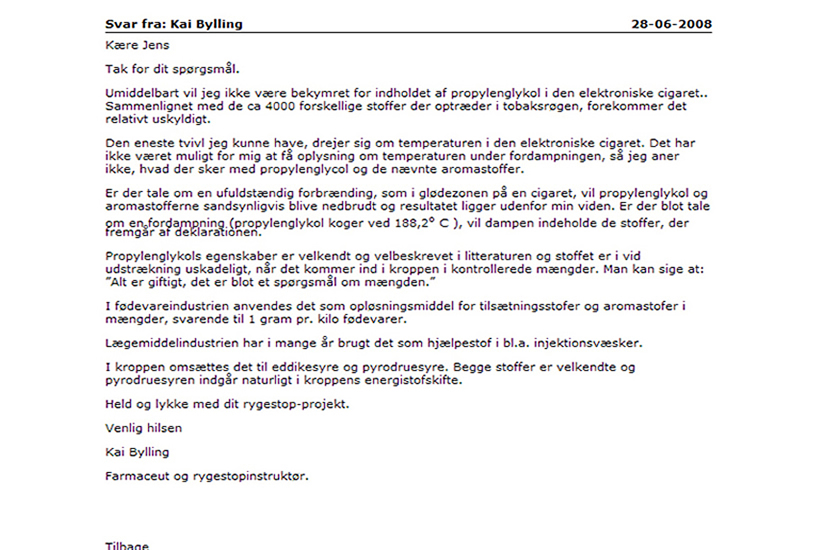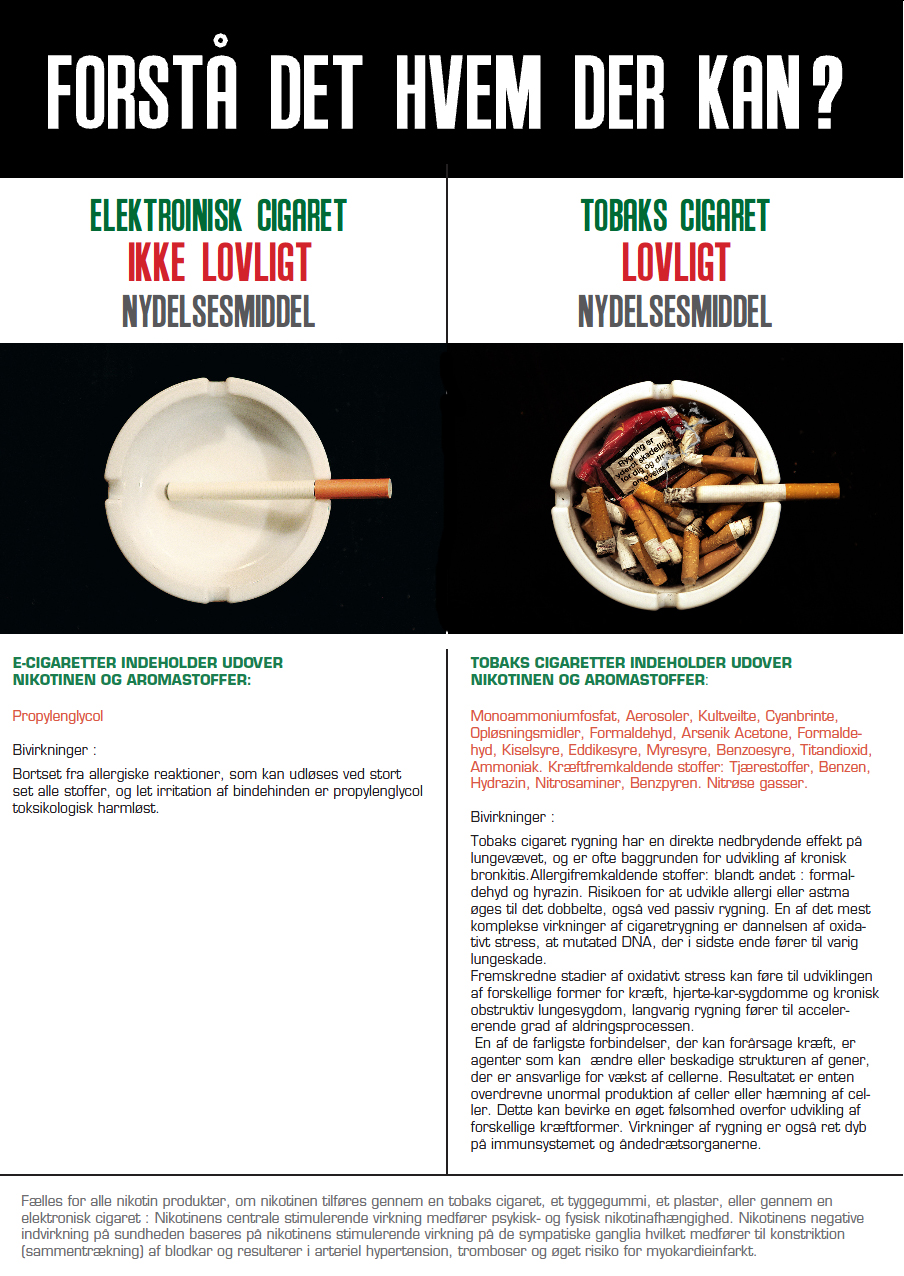|
|
?
Hvad er der i dampen? :98 % vand & propylen, aromastoffer samt nikotin *
*midlertidigt forbudt


Link til artikkel her Berlingske Kronik 25-juli 2009
Politikken 9 Maj 2009 Første artikel 
»Hvis folk går over til e-cigaretter og helt holder op med at ryge, vil det højst sandsynligt være positivt.
siger Niels Them Kjær, projektchef i Kræftens Bekæmpelse.
Ledende overlæge på Gentofte Hospitals lungemedicinske afdeling Philip Tønnesen har gennem 30 år forsket i rygestop. Han finder e-cigaretten spændende i form og indhold og har taget de indledende skridt til at lave en større undersøgelse af dem som middel til rygestop.
Mere effektivt til rygestop
»Som alternativ til tobaksrygning er elektroniske cigaretter klart at foretrække. Og jeg vil ikke umiddelbart vurdere, at den vanddamp, man inhalerer, kan være farlig«, siger Philip Tønnesen.
Fordi produktet simulerer rygning, kan det vise sig at være endnu mere effektivt end andre nikotinerstatningspræparater, mener Philip Tønnesen:
»I 90 procent af tilfældene ryger man cigaretter på grund af nikotinafhængigheden. Men den vanemæssige og smagsmæssige oplevelse ved at ryge spiller også ind«, siger han.
Philip Tønnesen og Kræftens Bekæmpelse understreger, at nikotinen i sig selv ikke er kræftfremkaldende.
Læs Politikken 16 Maj Nikotintyggegummi gir kræft
|
Download rapporter , info pjecer & foto-paa-vej
med DampCigaretter :
|
| NyCigarets pjece :" Forstå det hvem der kan " i PDF her |
| Kopi af NyCigarets redegørelse til ministeriet i PDF her |
Toxologi professors Mayers toxologi report om e-cigaretten i PDF her |
| Apoteket.dk lægen svarer på spørgsmål om e-røgen på link her |
En rapport om konsekvensen af rygning hos den danske arbejdsstyrke i PDF her
udarbejdet for Acceptable Choice : |
En rapport om holdninger til den elektroniske cigaret i PDF her
udarbejdet for Accepable Choice |
| Lægemiddelstyrelsens gør det officielt at E-Cigaretter uden nikotin er lovlige :" ikke vort borf": læs her |
|

 » »
Generelt findes der ikke nogen sunde tobaksprodukter. Når der er tobak i et produkt, er det per definition også sundhedsskadeligt.
Men når det er sagt, er risikoen for at blive syg af røgfri tobak noget mindre sammenlignet med rygning«, siger Jørgen Falk, konsulent i Sundhedsstyrelsens Center for Forebyggelse.
Philip Tønnesen Lungespecialist Gentofte hospital udtaler :
»Hvis jeg skal se på, hvad der er politisk muligt over de næste ti år, bør man indgå aftaler med tobaksproducenterne om at udfase cigaretterne for til sidst at forbyde dem.
I stedet skal industrien have lov til at sælge røgfri tobak med de samme klausuler om markedsføring som i dag. På den måde kan industrien stadig tjene penge, og vi vil reducere antallet af døde betragteligt«, siger Philip Tønnesen.
Det er velkendt at tobak der brænder, afgiver det kræftfremkaldede tjære og kulilte i modsætning til røgfri tobak med nikotin som bruges i vore nye dampcigaret refiller.
Interresant læsning om Propylen Glycol
Læs et indlæg fra New Zealand, hvor der argumenteres for at inhalering af Propylen Glykol (PG)
E-CIGARETTE USE - COULD IT PROTECT US ALL FROM THE NEXT PANDEMIC?
Murray Laugesen
Public health physician www.healthnz.co.nz
Bob Bowden, Florida contributor to e-cigarette-forum.com, raises the question whether e-cigarettes, apart from avoiding smoking and future lung cancer risk, actually confers immediate short term positive benefits, by reducing the risk of its users inhaling live viruses and bacteria from room air. This is mind-blowing enough, but could its possible benefits also protect others close by? Is the e-cigarette more than a tool for reducing harm? Is it also potentially a talisman to ward off infection?
History
That propylene glycol (PG) may protect users of the e-cigarette from airborne bacterial and viruses dates back to World War II. 'Air Germicide', a story in Time magazine Nov 16, 1942, reported the research of Dr. Oswald Hope Robertson at Chicago's BillingsHospital. He showed that half a part per million of PG in air could kill bacteria and viruses in that air within seconds. He found PG could protect mice from influenza virus, and that monkeys could well tolerate living in air containing PG. On the face of it, e-cigarette users might indeed be better off.
Second hand PG
For e-cigarette mist to have any chance of protecting non-users of e-cigarettes depends on whether e-cigarette users exhale sufficient PG, and this is doubtful. While the mouth smoke inhaled contains PG at 300 parts per million, in the next breath the exhaled mist is invisible and PG is only about 5 ppm. Several PG users, however, might exhale enough to maintain a viricidal concentration of PG. PG is mostly absorbed, and broken down to carbon dioxide and pyruvate, which is burnt for energy. And so PG mainly benefits the user, not the surrounding air space.
Protecting air travelers
Air travel is a weak point in defending ourselves internationally from fatal respiratory infections. Bird flu and pandemic influenza can spread globally at the speed of jet travel, as one infected person can infect many others through air-conditioned, re-circulated air. Governments are spending millions on how to contain or just even slow the spread of such epidemics. Perhaps PG should be seriously considered.
Even the tuberculosis bacillus can infect passengers seated some distance from the infected passenger on a flight between San Francisco and Hawaii, as CDC (US Centers for Disease Control) has reported.
PG is not used to sterilise aircraft air, and airlines medicating cabin air via air-conditioners could incur unwanted legal claims. Permitting the use, however, of e-cigarettes on passenger flights might at least help protect the e-cigarette user, and just possibly, those in the adjacent seat. Airlines would not need to do a thing, apart from inform in-flight staff that e-cigarette use is permissible.
E-cigarettes, being flameless, and not producing harmful gases, are not banned by laws against second-hand smoke or use in flight. Their use in the aircraft toilet will not activate the smoke alarms. And until research confirms or denies it, the PG in e-cigarette mist just might have health protection benefits for other passengers. Non-smokers desiring enhanced personal protection could use e-cigarettes containing zero nicotine.
Further research
We already know there is no way e-cigarettes can cause lung cancer. Equally, they do not cause fires. E-users would also like to know whether switching to e-cigarettes reduces coughs, colds and flu compared with smokers who have simply quit nicotine altogether. Everyone would like to know whether permitting e-cigarette use on long haul flights reduces respiratory infection risk for passengers. link til siden på nettet hvor det er klippet fra her
For mere info kig her: http://www.e-cigarette-forum.com/forum/ ... por-4.htmlA germ-killing vapor Far from posing a threat to our health, the propylene glycol in e-smoking liquids might help keep us healthy. It would accomplish that by its germicidal action. It kills many of the major bacteria that threaten lung entry into our bodies.
Until yesterday, I was unfamiliar with this potentially beneficial consequence of propylene glycol vapor.
Back in the late '30s, researchers at the University of Chicago stumbled onto its effectiveness as a germ-killer, as related in this Time magazine story from Nov. 16, 1942:
"A powerful preventive against pneumonia, influenza and other respiratory diseases may be promised by a brilliant series of experiments conducted during the last three years at the University of Chicago's Billings Hospital. Dr. Oswald Hope Robertson last week was making final tests with a new germicidal vapor - propylene glycol - to sterilize air. If the results so far obtained are confirmed, one of the age-old searches of man will finally achieve its goal...
"...the researchers found that the propylene glycol itself was a potent germicide. One part of glycol in 2,000,000 parts of air would - within a few seconds - kill concentrations of air-suspended pneumococci, streptococci and other bacteria numbering millions to the cubic foot.
"How did it work? Respiratory disease bacteria float about in tiny droplets of water breathed, sneezed and coughed from human beings. The germicidal glycol also floats in infinitesimally small particles. Calculations showed that if droplet had to hit droplet, it would take two to 200 hours for sterilization of sprayed air to take place. Since sterilization took place in seconds, Dr. Robertson concluded that the glycol droplets must give off gas molecules which dissolve in the water droplets and kill the germs within them.
"Dr. Robertson placed groups of mice in a chamber and sprayed its air first with propylene glycol, then with influenza virus. All the mice lived. Then he sprayed the chamber with virus alone. All the mice died."
The complete Time story can be read here: Air Germicide - TIME
In a scientific summary of the discovery, it was noted that "Tests on possible deleterious effects of breathing propylene glycol containing atmospheres over long periods of time are being carried out."
Those tests were done and a second summary report on propylene glycol vapor was released:
"Propylene glycol is harmless to man when swallowed or injected into the veins. It is also harmless to mice who have breathed it for long periods. But medical science is cautious - there was still a remote chance that glycol might accumulate harmfully in the erect human lungs which, unlike those of mice, do not drain themselves. So last June Dr. Robertson began studying the effect of glycol vapor on monkeys imported from the University of Puerto Rico's School of Tropical Medicine. So far, after many months' exposure to the vapor, the monkeys are happy and fatter than ever. Dr. Robertson does not expect mankind to live, like his monkeys, continuously in an atmosphere of glycol vapor; but it should be most valuable in such crowded places as schools and theaters, where most respiratory diseases are picked up."
The monkeys lived in enclosures filled with propylene glycol vapor. No deleterious effect was ever reported. And the concentrations of PG we inhale on a regular basis surely must equal the amount inhaled by the monkeys for this test. Obviously, no scientist saw a time when a device would atomize a PG mist that would then be inhaled for fun. But time and technology has given us the electronic cigarette. With each inhalation, we are washing our lungs with a germicidal agent used today in some "air sanitizers".
Glycerine, by the way, has some germicidal impact, but not, apparently, to the degree provided by inhaling propylene glycol vapor. Glycerine is now used by dairy farmers to help prevent bacteria entering a cow's teats after milking. Glycerine both softens the teats and kills bacteria.
One more quote on PG: "The vapour from as little as 0.5 mg of propylene glycol can kill nearly all the microorganisms in a liter of heavily contaminated air within 15 seconds."
The initial experiments with PG vapor were part of a search to find ways to create clean rooms, so the 1918 Spanish Flu pandemic that killed so many millions would never be repeated. Today, researchers have wondered online if propylene glycol vapor might not offer protection against a widely feared coming pandemic of bird flu, tagged H5N1.
Imagine e-smokers being healthier than non-smokers in such a scenario
Uddrag af medicinalsk test fra Health institut of NewZealand Summary
The Cigarette is designed to be a safe alternative to smoking, and on examination from a number of aspects, appears to achieve this aim. Its sophisticated electronics vapourizes, separately for each puff, very small quantities of nicotine dissolved in propylene glycol, two small well- known molecules with excellent safety profiles, – into a fine aerosol. Each puff contains one third to half the nicotine in a tobacco cigarette’s puff. The cartridge liquid is tobacco-free and no combustion occurs.
Once on sale, its on-going safety profile depends on 1) good manufacturing practice and pharmaceutical-grade purity of the nicotine and propylene glycol used in the cartridge liquid. 2) the prevention of shared use which could result in cross infection.
In early 2008, Clinical Trials Research Unit, University of Auckland is testing the e-cigarette’s efficacy in raising blood nicotine levels and in reducing cigarette cravings.Læs hele reporten her .pdfKlik her for original artiklen


Se hvordan refiller testes på fabrikken
video fra fabrikken 
  Nycigaret.dk Nycigaret1.dk NyCigaretten.dk NyCig.dk NyCigar.dk NyCigaret.com Nysmøg.dk Zigaret.dk eSigaret.dk eCigaret.dk Dampcigaret.dk DenRygerSgu.dk E-cig-rygning.dk E-cig-smoking.dk E-cig-best-i-test.dk E-Cigaretter.biz E-Cigaretter.eu E-cig1.dk E-cig-nu.dk E-cig-nyt.dk E-cig-salg.dk E-cig-kvalitet.dk E-Smoke.nu E-smoke.org E-Cigaretter.dk Nycigaret.dk Nycigaret1.dk NyCigaretten.dk NyCig.dk NyCigar.dk NyCigaret.com Nysmøg.dk Zigaret.dk eSigaret.dk eCigaret.dk Dampcigaret.dk DenRygerSgu.dk E-cig-rygning.dk E-cig-smoking.dk E-cig-best-i-test.dk E-Cigaretter.biz E-Cigaretter.eu E-cig1.dk E-cig-nu.dk E-cig-nyt.dk E-cig-salg.dk E-cig-kvalitet.dk E-Smoke.nu E-smoke.org E-Cigaretter.dk
E-Cigars.dk E-Cigarettes.asia E-zig.dk Ecigniko.dk Ecignico.dk Ecigaretter.dk ElektriskCigaret.dk ElektriskeCigaretter.dk ElektroniskeCigaretter.dk ElectronicCigarettes.dk Elektroniskrygning.dk NewCigaret.dk NewCigaret.com Nikotinen.nu Nikotinen.dk Nikotin.asia Nicotine.dk Nikotinfiltre.dk Nikotinfilter.dk Nikotinrefiller.dk Nonsmoking-nu.dk
 |
 |
 |
 |
 |
Camilla god service
Kunderne skriver |
Læs hvad pressen skrev |
Gå til webshoppen og se
hvad vi har at byde på |
Læs om vores nikotin sag |
Se video om ecigaretterne her |
|

